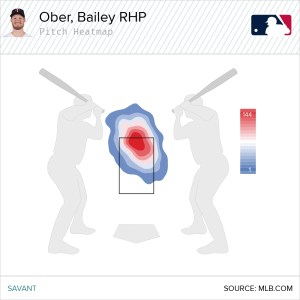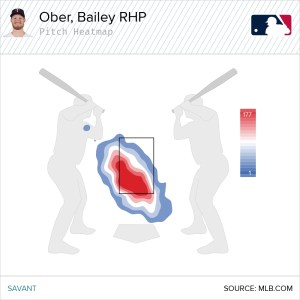Every year over the past handful of years, I have a series of articles I always do in the run-up to the fantasy baseball season taking a look at the best pitches of each pitch type from the previous year.
This is one of my favorite article series to do every year, not only because pitching is awesome and I love writing about it, but also because these articles are oftentimes interesting ways to dive into a pitcher’s repertoire, and can be a vehicle to find some underappreciated or undervalued pitchers.
I’ve always been a firm believer in trusting a pitcher’s stuff. Obviously there’s more to pitching than just a filthy arsenal, but that’s a great foundation to have, and if a pitcher has a pitch that’s fooling most hitters in the league, there’s potential there, even if the pitcher isn’t one of the best in the league.
In this article and the articles that’ll be coming after it, I’ll be taking a look at the five best pitches of each pitch type from last year. And just like I did last year, I’ll be ranking these pitches by our own metric, Pitch Level Value (PLV).
If you’re not familiar with what PLV is, some writer at this site named Nick Pollack wrote a whole primer on it with all the details you need to know. But here’s the short version: PLV is a numerical way to quantify the pure quality of a pitch regardless of the events that occurred around that pitch.
For example, if a pitcher throws a beautiful changeup down and away to a hitter that drops right off the plate and somehow that hitter is able to make contact and turn it into a double, that’s not necessarily the result of a bad pitch but of a good piece of hitting (and a bit of luck), so PLV tries to account for something like that.
One more quick note before we dive in—all the pitches included on these lists were thrown a minimum of 300 times last year. My goal with this series is always to highlight pitches that were thrown fairly frequently and were consistently dominant, and a minimum of 300 pitches is a good place to start.
Anyways, let’s dive into the five best changeups by PLV of 2023.
5. Bailey Ober
Bailey Ober is a really interesting guy—he mainly throws two pitches, a fastball and this changeup. Those two pitches made up around three-quarters of all his pitches thrown last year (he’s also got a slider he throws 20% of the time and a curveball that’s thrown just 7% of the time).
After a pretty impressive but brief 11-start stint in 2022, Ober really impressed last year through 26 starts and 144.1 innings, pitching to a 3.43 ERA alongside a 3.43 xERA (don’t see that too often) and a 3.96 FIP.
What I love about Ober is he has a very clear approach to how he pitches. Take a look at where he locates his fastball and his changeup:


I love that approach—Ober throws his fastball high and his changeup low, and what’s awesome is how consistently he’s able to keep that fastball up high. It’s a solid approach that especially works well getting lefties out—last year, left-handed hitters had just a .276 wOBA against Ober.
The fastball obviously isn’t his out pitch but it does a good job of setting up the changeup while still limiting hard contact, and given the extension he’s able to get on the pitch with solid IVB and a decent VAA, the pitch should remain fairly effective up in the zone where he’s locating it.
But we’re here to talk about the changeup! And the changeup was awesome last year—opposing hitters had just a 29% ICR against the pitch alongside a 38.2% chase rate, 17% swinging-strike rate, and a 30.4% CSW. So basically, hitters chased and missed the pitch a lot and even if they did make contact, they weren’t making hard contact.
Now, here’s where I’m excited about Ober’s potential. Obviously the fastball is solid and the changeup is awesome, but two pitches aren’t enough (most of the time) to be a consistently good starting pitcher in the majors.
The slider leaves a bit to be desired—opposing hitters had an 11.9% barrel rate and a 41.8% ICR against the pitch last year, both numbers that are notably worse than average for sliders. And, what’s worse, it wasn’t all that great at inducing swings and misses, with a 32.7% chase rate, 14.9% swinging-strike rate, and a 29.3% CSW, all of which are pretty average numbers for the pitch.
Similarly, the curveball didn’t produce eye-popping numbers, but at the same time, he only threw it 7% of the time last year, so it’s hard to really make a judgment on that.
But if Ober is able to turn that slider (or the curveball, but preferably the slider) into a legit third pitch, we’re looking at a guy who could really turn in a solid, consistent season. He’s already got the fastball, he’s already got the changeup, and he’s already shown that just having those two can work pretty darn well. But adding another pitch would really take him to another level.
If you’ve watched Devin Williams at all, it shouldn’t be all that surprising that he’s in a list of the best changeups in the league—his “airbender” is a thing of beauty.
I mean, just run the gamut on stats for the pitch, they’re all beautiful—last year, Williams’s changeup had a 42.3% chase rate, 22.6% swinging-strike rate, and a 34.2% CSW, all exceptional numbers. And even better, it had a 32.5% ICR, so even if guys made contact, they weren’t doing much with it.
And on top of that, Williams had excellent command of this changeup, with a 1.6% mistake rate on the pitch (that’s the percentage of pitches in the zone with a PLV less than 4.5), well below the MLB average for relievers of 8.9%.
I really can’t emphasize enough how cool of a pitch this changeup is to me. The way this thing moves is wild—Williams’s changeup gets 12.1 inches of horizontal movement and not a ton of vertical drop, making it more like a screwball than anything else.
While the changeup is the main selling point for Williams, he pairs it with a really solid fastball that averages around 94 MPH and logs an awesome 37.2% CSW and 15.9% swinging-strike rate. Part of the effectiveness of this pitch comes from the ridiculous 7.7 feet of extension Williams gets on it alongside a 1.4 height-adjusted VAA. Basically, the pitch comes in fast and it looks like it’s moving even faster to hitters.
That said, the fastball isn’t perfect, as it’s worth noting opposing hitters did have a 56.3% ICR against the pitch last year, which is very bad. But with that changeup and a fastball that can get some whiffs, you can live with that.
Garrett Whitlock bounced between the bullpen and the rotation last year, pitching in 22 games and starting in 10, and did not have a lot of success—pitching to a 5.15 ERA alongside a 4.81 xERA and a 4.28 FIP.
Where Whitlock did have success was this changeup! Whitlock threw the pitch 24% of the time last year and it worked pretty darn well, to the tune of an 18.8% swinging-strike rate and a 46.5% chase rate, both numbers that are well above average. The CSW on the pitch wasn’t as great at 27.8% but it’s not bad either, and it’s mainly because he didn’t get all that many called strikes on the pitch.
It’s a great pitch with a ton of spin on it, coming in at a 2,129 RPM rate—which is roughly 400 RPMs above average—and a bunch of movement, averaging 10.1 inches of horizontal break which is again, well above average.
It’s a beautiful pitch but one that wasn’t without its flaws—last year, opposing hitters had a 40.8% ICR and a .370 wOBA against the pitch, which is not great.
But the real trouble for Whitlock last year was his sinker, which opposing hitters had a .392 wOBA against and a 19.4% HR/FB rate, though the fact that Whitlock’s sinker saw a .363 xwOBA and a 39.8% ICR (which isn’t great but also isn’t terrible), suggests there may have been a bit of bad luck.
Whitlock clearly has an awesome changeup, and alongside it, he’s got a pretty sweet slider that posted a 22.3% swinging-strike rate and 37.2% CSW last year, both excellent number. But that sinker is a real problem, and depending on whether Tanner Houck beats him out for a rotation spot, he might be back in the bullpen.
Michael Wacha’s season last year is so interesting to me. Between 2019 and 2021, Wacha was borderline unusable as a starting pitcher, with an ERA of 4.76, 6.62, and 5.05 each year, respectively. And then in 2022 with the Red Sox, Wacha starts 23 games to the tune of a 3.32 ERA out of nowhere, posting a career-best year. Then, last year with the Padres, Wacha does it again, starting in 24 games and pitching to a 3.22 ERA.
So what changed? It was this pitch—his changeup. Before 2022, Wacha was using his changeup more like a secondary pitch and relying on his (not very good) fastball. Then, in 2022, he started throwing the changeup just as much as he did the fastball, starting to pitch backwards a bit. He continued that last year, throwing his changeup 34% of the time and his fastball 29%.
And it’s this changeup that’s helping him a ton. It’s a pitch that has more vertical break to it than horizontal—quite a lot actually, to the tune of 7.8 inches of induced vertical break, which is a lot for a changeup. It worked too—last year the pitch had a 44.4% chase rate and a ridiculous 21.3% swinging-strike rate to go with a 31.7% CSW and 33.1% ICR.
That’s a bunch of numbers to basically say Wacha’s changeup is a great putaway pitch that also induces weak contact.
The problem? Much like Whitlock, the changeup is basically all Wacha has. Here’s a look at the rest of the repertoire last year:

That changeup is quite the outlier. The fastball comes in fairly average, though given the pitch has a whole bunch of IVB on it with a steep VAA, Wacha’s able to effectively use it to steal a called strike low in the zone here and there (although the 40.4% ICR against it isn’t the most encouraging stat).
But the rest of the repertoire isn’t great, and alongside some of Wacha’s peripherals like his 4.03 xERA does make me a bit nervous, as does his propensity for injury.
That said, his 3.32 ERA in 2022 also came with a 4.25 xERA and 4.15 FIP, and it’s worth noting that his FIP last year dropped down to 3.89, so it’s entirely possible he proves us all wrong again, and given he’s on the Royals now, he’ll definitely have the opportunity. I just worry about guys who are essentially one-pitch pitchers, and especially if that one great pitch is a changeup.
1. Yennier Cano
If you watched the Orioles last year (and if you didn’t, what is wrong with you??) you know how filthy Yennier Cano can be.
Coming over to the Orioles in 2022 in the trade that sent Jorge López to the Twins and also netted Cade Povich for the Orioles, Cano pitched 72 games out of the bullpen last year and was dominant—pitching to a 2.11 ERA and 2.84 FIP.
Cano mainly goes with a sinker/changeup combo, tossing in a slider just 14% of the time and occasionally throwing in a four-seam fastball. The sinker worked great, clocking in around 96 MPH on average with a bunch of horizontal movement and logging a rock-solid 30.9% CSW with an awesome 28.7% ICR.
But we’re here to talk about the changeup, and what a changeup this is. The pitch averages around 90 MPH and comes in with 11.1 inches of horizontal movement (well above average for a changeup) and hitters couldn’t do anything with it.
The pitch logged a 46.7% chase rate and a 23.4% swinging-strike rate alongside a .219 wOBA against. Now, it also had a 41.5% ICR against it, which isn’t great (but also isn’t terrible), but all in all, Cano’s changeup was an absolutely killer putaway pitch and helped propel him to an All-Star appearance and an incredible season.
Feature image by Michael Packard (@artbymikep on Twitter) / Photo by Scott W. Grau & Cliff Welch / Icon Sportswire

